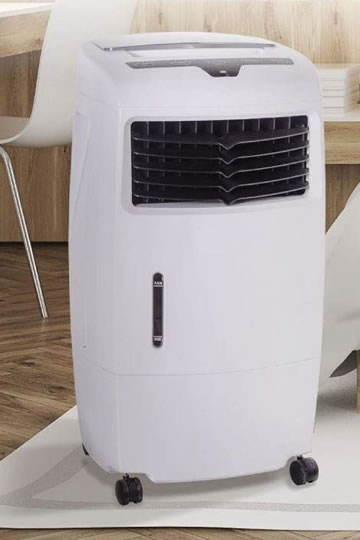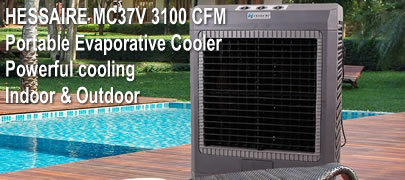How Well Do Ventless Air Conditioners Work?
With the ever rising cost of energy for homes and businesses, it is natural to want to know how well ventless air conditioners work since they represent low cost cooling when compared to refrigerant-based air conditioners.
Let's look at why this is.
 Air conditioners are machines that take heat and humidity from the air in your room and transfer it outside., which cooling the air inside.
Air conditioners are machines that take heat and humidity from the air in your room and transfer it outside., which cooling the air inside.
Air conditioning devices must be installed along with some form of ducting to allow the hot, moist exhaust air to escape to the outside.
Portable units need to be vented through a window using a vent hose.
However, in the process of chilling the indoor air, air conditioners use a lot of energy.
This is evident when the next electricity bill arrives.
Evaporative Air Cooler
A ventless portable air conditioner, which is in reality an evaporative cooler, or "swamp cooler," is essentially a combination of a humidifier plus a room fan.
By evaporating moisture using the fan to push air through a damp membrane, the appliance sends out cold air into the room.
Since there is no refrigeration or mechanical motor in these devices, they use much less electricity to run just a fan, a small pump and the display face.
This can equate to between just 1/10th and 1/20th the amount of energy required by a normal, refrigerant-based portable air conditioner.
Recommended Model

Click to Read My Review
What is Evaporative Cooling?
Evaporating water cools the air in the same way that melting ice cools food in a cooler: It absorbs extra energy as it changes phases.
Evaporated water is essentially a collection of high-energy molecules moving around the room. Water absorbs a lot heat energy, making its molecules less active, reducing the temperature.
It's easy for water to evaporate in hot, dry conditions. To speed up the process, swamp coolers spread the water over a sponge-like filter, pushing air through it with the fan.
Evaporative coolers can continue to work until the air becomes too humid to absorb any more water vapor.
They work best when some of the cool air is allowed to escape and hot dry air can come in through open windows or doors to replace it.
Where Can Evaporative Coolers be Effective?
Evaporative cooling works better when the air is dryer. On the map above, we used data from the National Atmospheric and Oceanic Administration to map out summertime temperatures and humidity in three conditions where evaporative cooling can work:
- Regions with less than 45% daytime humidity and temperatures below 90°F are ideal
- Regions with similar humidity levels but temperatures higher than 100°F
- Regions with higher temperatures than 100 degrees and high summer humidity of 45-55% are less suitable
Extreme differences exist between cooling in an ideal zone and areas with higher humidity. Extra-dry air with 15% relative humidity and 90°F temperatures can be cooled effectively by an evaporative system by as much as 29°.
The same system at 50% relative humidity will cool the air by only 15°F and it will feel clammy.
You can see that the areas where evaporative cooling is most effective don't cover a lot of the United States population.
If you live in the dry Southwest or in some other areas where the air is relatively dry, evaporative cooling may be an option. This is a low-cost method to cool down a room.
Evaporative cooling is a good option in hot desert climates. However, you will find it more effective in an outdoor swamp cooler that has a larger fan blowing through the ducts and an automated water supply.
Portable Air Conditioners vs Ventless Air Coolers
From an economy standpoint, it all comes down to the local climate when deciding between these types of systems.
Ventless air conditioners, which are far more economical to run than true portable air conditioners, work best in dry areas where evaporative cooling is effective. They will humidify your air and be just as effective at cooling you as portable ACs.
The negative side to this equation is that an evaporative cooler will not work in humid areas, making a more expensive to run portable AC the only viable choice of effective cooler.
Dry Conditions
Hot, dry air is the perfect medium to be cooled by a swamp cooler. The humidity increase from evaporated water will provide a refreshing alternative for the moisturizing and speciality soaps that you use to keep your skin from drying out.
A combination of shade and cool water from an insulated container, as well as an evaporative cooling cooler, can make desert conditions bearable for most people.
Running an air conditioner, however, will dry your air out even more. Although portable air conditioners can cool the air beyond the chilling coil, even the most powerful dual-hose portable conditioners are unable to maintain room temperatures below 75°F during summer heat waves.
If you require significant cooling in very hot conditions, central, mini-split or window AC systems will work better.
Humid Conditions
Evaporative systems are unable to function as intended in conditions exceeding 60% relative humidity.
If there is already humidity in the outdoor air, the energy that can be absorbed by an evaporative cooler will not be enough. The air will become so humid inside, you might just have to turn it off.
The portable air conditioner is very similar to a stand-alone dehumidifier, but they release all heat that they have absorbed and any heat that the compressor has out the window rather than back into your home.
In self evaporating air conditioners, the water that they capture is used to cool the components of the appliance, increasing efficiency and reducing the need to empty a tank every so often.
Summary
The bottom line with regards to how well a ventless air conditioner (evaporative cooler) will work comes down to the relative humidity in the air in your location.
Low humidity areas are perfect for swamp coolers which can reduce the air temperature indoors by a significant amount, making it feel cooler and more pleasant.
High humidity areas are no good for swamp coolers, as they are unable to chill air that is already saturated with moisture. In this case, a true air conditioning solution is the better choice.
Last Updated: April 21, 2025
[Back to Top]